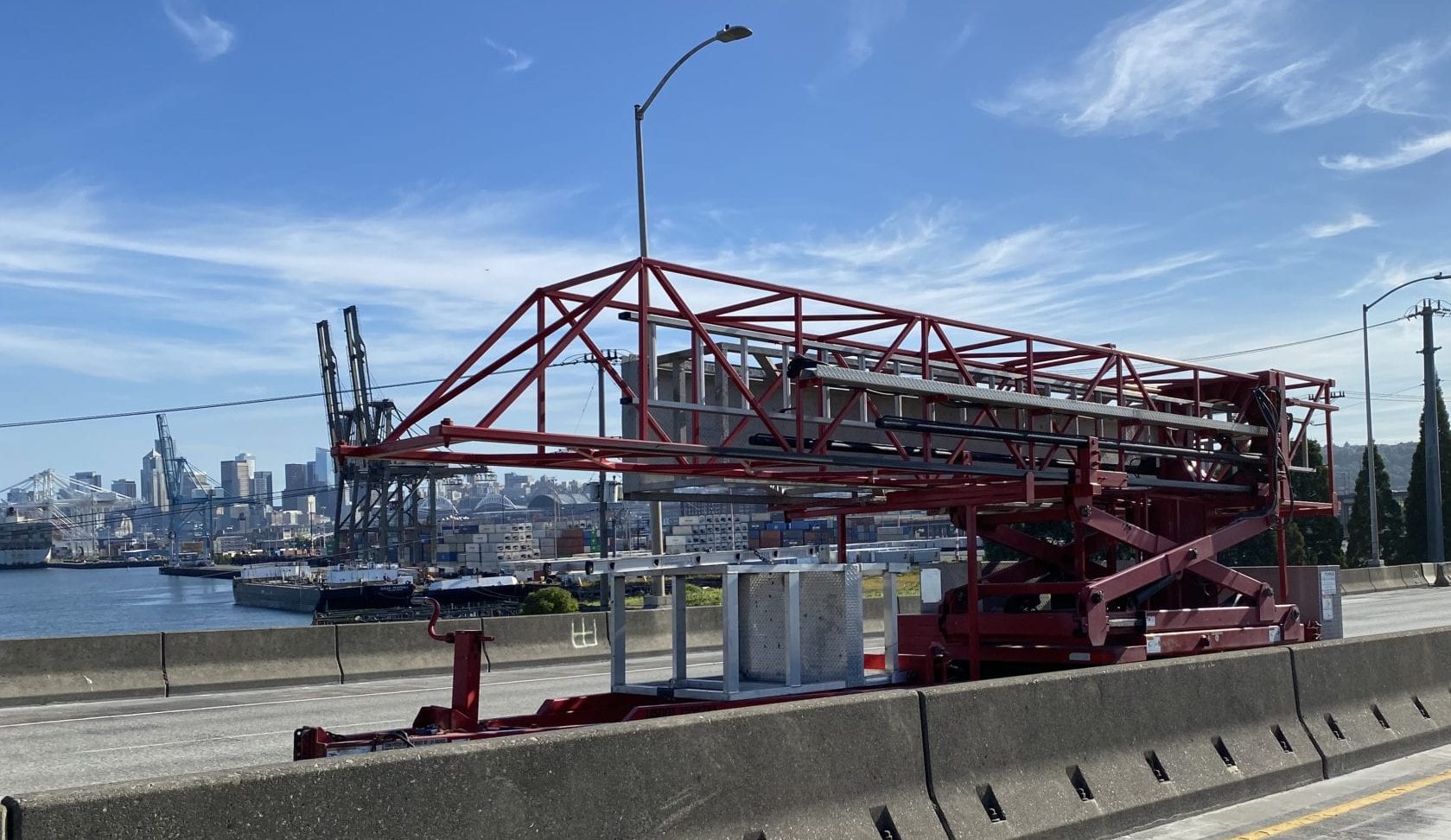
You may have already seen crews staging equipment near the High-Rise Bridge last week – including bringing in a Hydra-Lift Under-Bridge Inspection Platform, pictured above.
Stabilizing the High-Rise Bridge is a necessary next step toward either repairing the bridge or preparing it for demolition and replacement of some kind.
Though our recent analysis indicates that repairing the West Seattle High-Rise Bridge may be possible, we still do not know how much repairs would cost, how long they would take, how many lanes could be restored, and whether repairs would last long enough to be a worthwhile investment. As we continue gathering information to help inform our decision to repair or replace, we are moving forward with this crucial stabilization work.
The first step of this stabilization work is to construct and attach movable work platforms to the underside of the High-Rise Bridge.
As soon as this week, our contractor, Kraemer North America, will begin work to attach these platforms to the bridge. The platforms will allow the team to safely access the exterior of the bridge girders to work on measures intended to slow cracking – this includes wrapping sections with carbon fiber-reinforced polymer (also known as a carbon fiber wrap or CFRP, a technique we recently used on the Cowen Park Bridge), adding external post-tensioning tendons, and releasing the bearings at Pier 18. (In this case, “external” is not what you might think. Read on for more details below.) The bridge has to be stabilized with the carbon fiber wrapping and external post-tensioning before we can release the bearing at Pier 18.
To secure these work platforms to the bridge in a way that enables them to reach different areas, the team will use the holes that are already on the bridge from the original “form travelers” that were used to construct it.

Form travelers provide the frame for forming each concrete segment in a balanced cantilever cast-in-place structure like the West Seattle High-Rise Bridge. On the West Seattle High-Rise Bridge, form travelers were “underslung,” meaning they moved along the bottom of the bridge as construction progressed. This stabilization work will not require form travelers but will suspend the work platforms from the same place.
To access the form traveler holes, which run vertically through the deck, and secure the movable work platforms to the bridge, the contractor will use a precision hydro-demolition technique with a tool similar to an extremely powerful pressure washer to erode the concrete in the holes.
While it is possible to use a core drill, this runs the risk of cutting into rebar or a steel tendon, which could damage the structural integrity of the bridge.

To do this hydro-demolition work, the teams will use a platform suspended by a truck on the roadway above (called a Hydra-Lift Under-Bridge Inspection Platform) to access the underside of the deck.
Hydro-demolition techniques require water, so under each drill location, the team will suspend a bucket to catch the water each hole will generate. The recovered water will be pumped through a hose up to a vacuum truck on the bridge’s roadway. The vacuum truck will transport the water to a location under the west side of the bridge, where a containment system will treat the water before releasing it into the sewer system.
Crews will open up more than 100 of these holes, and it will take a minimum of 2 weeks. Only once the holes have been exposed can the work platforms be hoisted up from a barge in the river below using roadway-mounted electric winches.
When the work platforms are secure, the team will be able to work from both the top and underside of the bridge, and move forward with the stabilization measures which, again, include wrapping sections with a carbon fiber wrap, adding external post-tensioning tendons, and releasing the bearings at Pier 18.
Carbon fiber wrapping will likely begin as soon as late July with external post-tensioning to follow.
Once the work platforms are in place, the team will use a core drill to install new holes to secure the steel beams that the post-tensioning strands will be anchored to. Once all of the holes have been drilled, we will begin to install the carbon fiber wrapping around the bottom of the bridge in areas where strengthening is required and inside some of the girders most affected by cracking. Once the carbon fiber wrap is set, we can begin installing the external post-tensioning strands. There will be some overlap of carbon fiber wrapping work and external post-tensioning installation.
When you think “external” post-tensioning, you might envision a whole network of steel tendons on the outside of the bridge. But external in this case means that it is not embedded in the concrete.
The steel tendons will actually be inside the box girders, as noted in the diagram below. From the outside of the bridge, you will not see the steel tendons except for where they anchor to the bottom of the bridge.

All of the steel tendons will run along the inside of the bridge girders and will be anchored to beams that we will secure using previously drilled holes. Once the strands are in place, we will begin to tighten (post-tension) them to achieve the required tension that will support the bridge and, with the carbon fiber wrap, help slow cracking.
The initial carbon fiber wrapping will take approximately 10 weeks, with initial post-tensioning strand installation beginning a bit after the carbon fiber wrapping and completing a week or two later. Only after these initial stabilization measures are complete can the release of Pier 18 take place. Once Pier 18 has been released, we will go back and complete carbon fiber wrapping and post-tensioning.